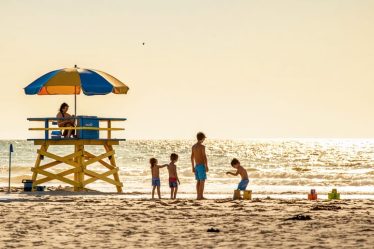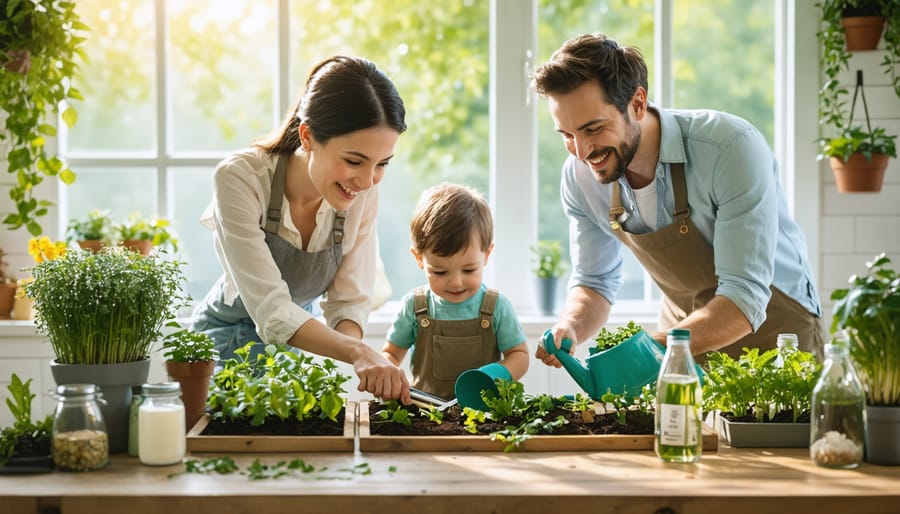
Embrace sustainable parenting and raise eco-conscious kids with these practical strategies:
- Model green habits like reducing waste, conserving energy, and choosing reusable products to instill eco-friendly values from an early age.
- Involve children in sustainable activities such as gardening, composting, and upcycling projects to nurture their connection with nature and teach responsible consumption.
- Opt for eco-friendly toys, clothing, and gear made from natural, organic, or recycled materials to minimize your family’s environmental impact while supporting ethical brands.
- Cultivate a love for the planet by spending time outdoors, exploring local parks, and participating in community clean-ups or environmental initiatives as a family.
By integrating these sustainable practices into your daily life, you’ll empower your children to become mindful, compassionate stewards of the Earth while strengthening your family bond through shared eco-conscious values.
Choose Reusable Over Disposable
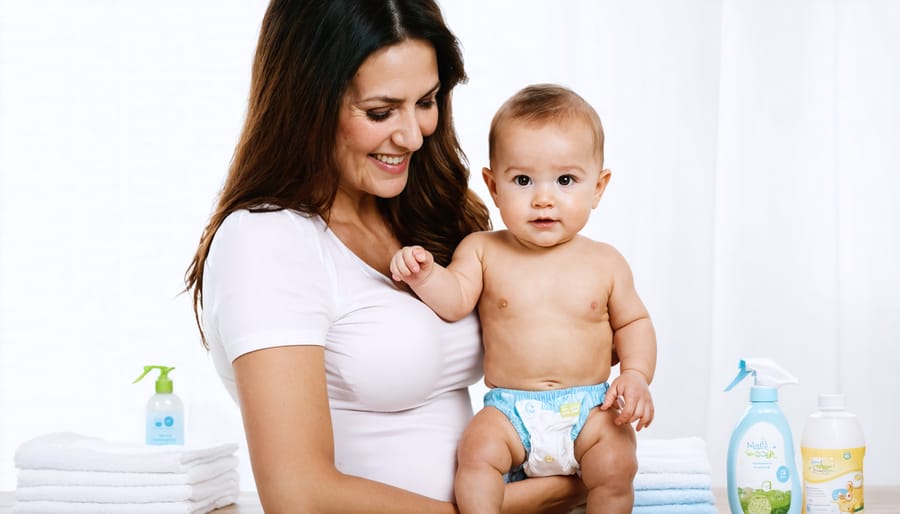
Cloth Diapering 101
Cloth diapering is a sustainable parenting choice that’s gaining popularity. While it may seem daunting at first, many parents find it to be a rewarding and eco-friendly option. The main pros include reducing waste, saving money in the long run, and using gentler materials on your baby’s sensitive skin. However, there are some cons to consider, such as the initial investment in diapers and the extra laundry.
To get started, you’ll need a stash of cloth diapers, which come in various styles like prefolds, pockets, and all-in-ones. You’ll also want to have diaper covers, snaps or pins, and a wet bag for storing dirty diapers until wash day. When it’s time to clean the diapers, simply toss them in the washing machine with a gentle detergent and dry them according to the manufacturer’s instructions.
Many parents find that once they establish a routine, cloth diapering becomes second nature. Plus, seeing those adorable fluffy bums and knowing you’re making a positive environmental impact can be really rewarding. If you’re considering giving cloth diapering a try, connect with local parenting groups or online communities for support and advice from experienced cloth diapering families.
Sustainable Feeding Options
As a new parent, you may feel overwhelmed by the array of baby products on the market. When it comes to feeding your little one, choosing sustainable options not only benefits the environment but also instills eco-friendly values from an early age. Opt for reusable bottles made from glass or stainless steel, which are durable, easy to clean, and free from harmful chemicals. When your baby starts solids, invest in a set of colorful, non-toxic plates and utensils designed to last through the toddler years and beyond. Silicone or bamboo are great alternatives to plastic, as they are long-lasting and biodegradable. For food storage, consider using glass containers with airtight lids or reusable silicone bags, which can be safely washed and used repeatedly. By making these simple swaps, you’ll reduce waste, save money in the long run, and create a more sustainable lifestyle for your family. Remember, every small change counts, and your eco-conscious choices will have a lasting impact on your child’s future.
Embrace Minimalism and Secondhand Items
Embracing minimalism and choosing secondhand items whenever possible are two powerful ways to make your parenting journey more sustainable. By reducing unnecessary purchases and opting for pre-loved goods, you can significantly lower your family’s environmental impact while saving money in the process.
One of the most effective ways to minimize consumption is to carefully consider each purchase and ask yourself if it’s truly essential. Before buying new toys, clothes, or gear for your little one, take a moment to reflect on whether you already have something that could serve the same purpose. Encourage your children to cherish and care for the items they already own, fostering a sense of gratitude and resourcefulness.
When you do need to make a purchase, consider exploring secondhand options first. Thrift stores, consignment shops, and online marketplaces are treasure troves of gently used children’s items at a fraction of the cost. From clothing and shoes to books and toys, you can find nearly everything your child needs without contributing to the demand for new production.
Not only does buying secondhand help reduce waste and conserve resources, but it also supports local charities and keeps money within your community. Plus, the thrill of the hunt can be a fun and rewarding experience for both you and your children, teaching them the value of being thrifty and creative.
By embracing minimalism and prioritizing secondhand items, you’ll be setting a powerful example for your children, showing them that a fulfilling life isn’t about accumulating possessions but rather about cherishing experiences, relationships, and the world around them. As they grow, they’ll carry these values with them, creating a ripple effect of sustainability for generations to come. For more tips on simplifying life through minimalism, explore 10 inspiring minimalist living examples.
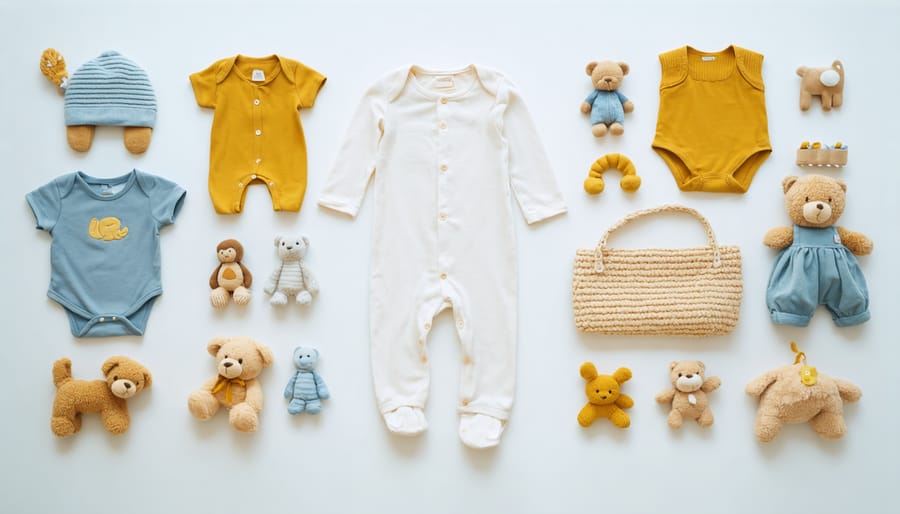
Teach Eco-Conscious Habits Early
Introducing eco-conscious habits at an early age sets the foundation for a lifetime of sustainable living. Start by modeling green practices yourself, like turning off lights when leaving a room, fixing leaky faucets promptly, and opting for reusable items over disposables. Explain your actions in simple terms to help kids understand the importance of conservation.
Make recycling a fun family activity by setting up separate bins for paper, plastic, and glass. Encourage little ones to sort items and praise their efforts. Create a reward system, like earning stickers or points towards a special outing, to reinforce positive habits.
Engage kids in age-appropriate green tasks, such as helping to hang laundry outside instead of using the dryer, or planting a small vegetable garden together. Discuss how these actions help protect the environment and save resources. Use everyday moments, like grocery shopping, to teach about eco-friendly choices, such as choosing products with minimal packaging or buying local produce.
Encourage a love for nature through outdoor adventures and exploration. Visit local parks, beaches, or nature trails, and discuss the importance of preserving these spaces. Participate in community clean-up events or organize your own neighborhood litter pick-up to foster a sense of responsibility for the environment.
At home, create a minimalist layout and involve kids in decluttering and donating unused items to charity. This teaches the value of consuming less and reducing waste. By making eco-conscious habits a natural part of daily life, you empower your children to become environmental stewards of the future.
Create a Non-Toxic Home Environment
Creating a non-toxic home environment is a crucial aspect of sustainable parenting. By choosing natural, organic, and non-toxic products for cleaning, body care, and baby items, you can minimize your family’s exposure to harmful chemicals and protect their health. Start by reading product labels carefully and opting for eco-friendly alternatives whenever possible.
When it comes to cleaning, consider making your own cleaners using simple ingredients like vinegar, baking soda, and essential oils. These DIY solutions are not only effective but also safer for your family and the environment. If you prefer store-bought cleaners, look for brands that prioritize natural and non-toxic formulations.
For body care and baby products, choose items made with organic and gentle ingredients. Avoid products containing parabens, sulfates, phthalates, and synthetic fragrances, as these can irritate sensitive skin and have potential long-term health effects. Opt for fragrance-free or naturally scented products, and always do a patch test before using new items on your baby’s delicate skin.
When shopping for baby gear, such as cribs, strollers, and car seats, look for products made with non-toxic materials and finishes. Choose furniture made from solid wood instead of pressed wood, which can emit formaldehyde. Select mattresses and bedding made from organic cotton, wool, or natural latex to ensure your baby has a safe and comfortable sleeping environment.
Remember, creating a non-toxic home is an ongoing process. Take small steps to gradually replace conventional products with safer alternatives, and don’t be too hard on yourself if you can’t make all the changes at once. By incorporating these green practices into your daily life, you’ll be well on your way to providing a healthier, more sustainable environment for your family.
Cultivate a Love of Nature
Cultivating a love for nature in our children is one of the most beautiful gifts we can give them. Not only does outdoor playtime promote physical health and cognitive development, but it also fosters a deep appreciation for the environment that will stay with them for life. As parents, we can encourage this connection by making eco-friendly activities a regular part of family life.
Try planning weekly nature walks or hikes, and use them as opportunities to teach your kids about local flora and fauna. You can even turn it into a game by challenging them to spot different types of birds, trees, or flowers. Gardening is another great way to get kids excited about the natural world. Let them help you plant a vegetable patch or create a pollinator-friendly flower bed using natural, organic, and non-toxic products. They’ll love getting their hands dirty and watching their efforts bloom.
On rainy days, bring nature inside with fun craft projects using recyclable materials like egg cartons, toilet paper rolls, and old magazines. Not only will you keep them entertained, but you’ll also teach them the value of reducing waste. By making eco-friendly activities a joyful and regular part of family life, we can raise a generation of nature lovers who are committed to protecting our planet, inspired by examples from outdoor adventures that the whole family can enjoy.
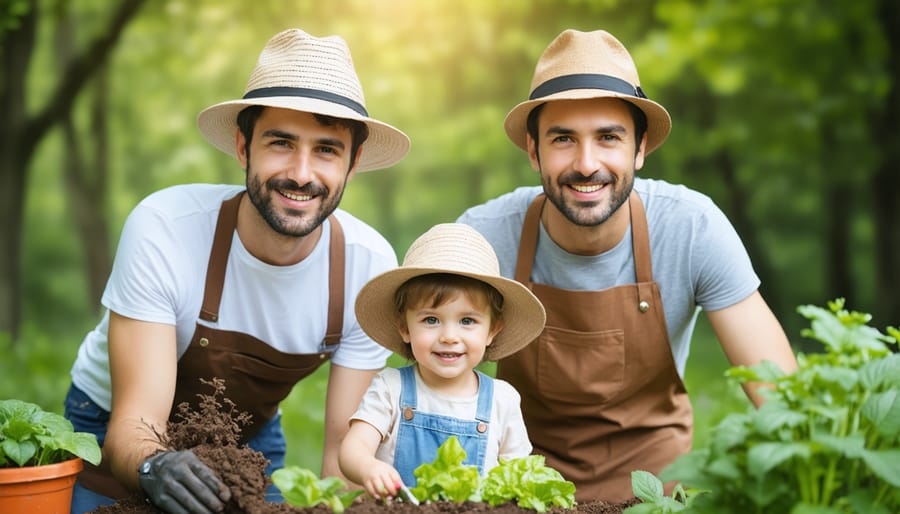
Join a Like-Minded Community
Finding a supportive community is essential when embarking on your sustainable parenting journey. Connecting with like-minded individuals who share your values and face similar challenges can provide encouragement, advice, and a sense of belonging. Start by searching for local groups focused on eco-friendly living, green parenting, or zero-waste initiatives. Attend meetups, workshops, or playdates to exchange ideas and build friendships with other environmentally conscious families.
Online forums and social media groups are also valuable resources for sustainable parenting support. Join Facebook groups, follow Instagram accounts, or participate in Reddit discussions related to green parenting topics. These virtual communities offer a wealth of knowledge, inspiration, and problem-solving tips from parents around the world. Remember to engage respectfully, share your own experiences, and offer support to others when possible.
Additionally, seek out trusted websites and blogs dedicated to sustainable parenting. Look for resources that align with your values and provide practical, evidence-based advice. Some popular options include Green Child Magazine, EcoParent, and Mindful Momma. Subscribe to their newsletters, read their articles, and download any available guides or worksheets to further your knowledge and stay motivated on your eco-friendly parenting path.
Conclusion
Sustainable parenting offers numerous benefits for your family, the environment, and future generations. By making eco-friendly choices, you’ll reduce your household’s carbon footprint, save money on energy and consumer goods, and teach your children valuable life lessons about responsibility, mindfulness, and caring for the planet. Remember, every small change counts, so don’t feel pressured to overhaul your entire lifestyle overnight. Start with simple swaps like reusable bags and water bottles, and gradually work towards bigger goals like composting or going zero waste. Celebrate your successes along the way and support each other as a family in your eco-friendly journey. By modeling sustainable habits and involving your kids in the process, you’ll help shape a new generation of environmentally conscious individuals who will continue making a positive impact long into the future. So take that first step today, and feel proud knowing that your choices as a parent are creating a cleaner, greener world for all.

